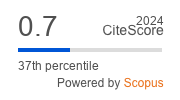Frozen Shoulder in Type 2 Diabetes Mellitus
Keywords:
Type 2 diabetes mellitus, Frozen shoulder, Glycated hemoglobinAbstract
Background: Frozen shoulder affects 2-5% of the
general population, and around 10-30% of diabetic
patients. It affect mainly the non-dominant shoulder,
and has more incidence in patients with poor
glycemic control.
Objective: To detect the incidence of frozen
shoulder in type 2 diabetic patients attending the
Specialized Center for Endocrinology and Diabetes
in Baghdad.Patients and methods: One hundred
patients with frozen shoulder were included in the
study from a total number of 580 type 2 diabetics
over a period of six months. 70 patients were
females and 30 patient were males. All were
investigated for fasting blood
glucose and HbA1c.
Results: The non-dominant shoulder was
involved in 60 patients (60%), the dominant
shoulder in 35 patients (35%) and bilateral
involvement in 5 patients (5%). 60 patients
(60%) had poor glycemic control (HbA1c > 8%).
Conclusion Diabetes mellitus is one of the
predisposing factors for the development of
frozen shoulder which affect 17.2% of type 2
diabetic patients in our study, most of them were
overweight- obese and had poor glycemic
control













